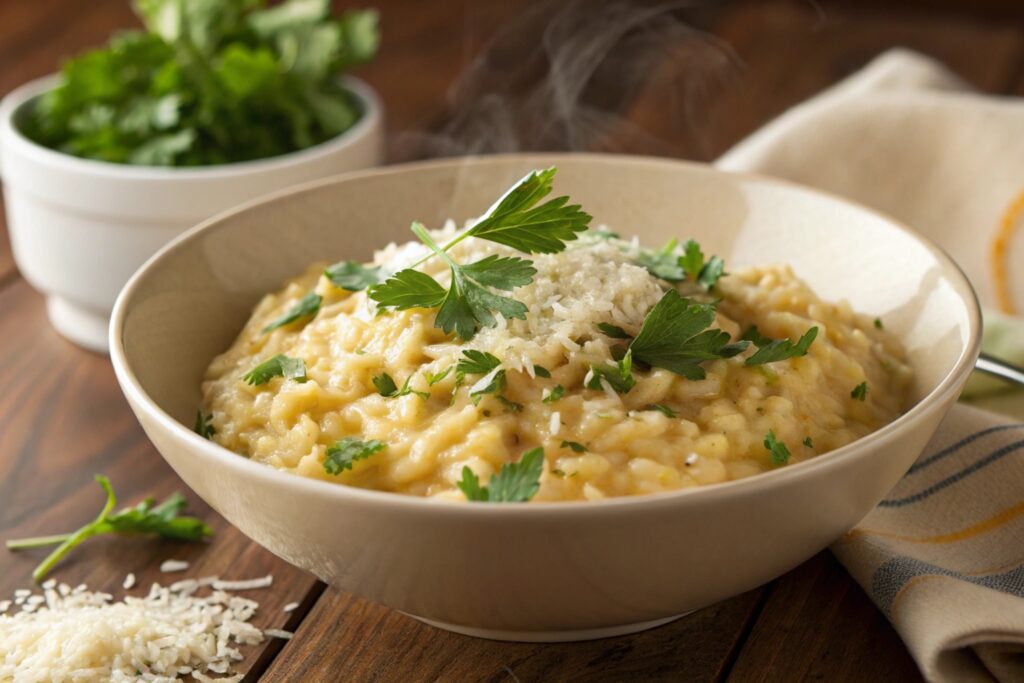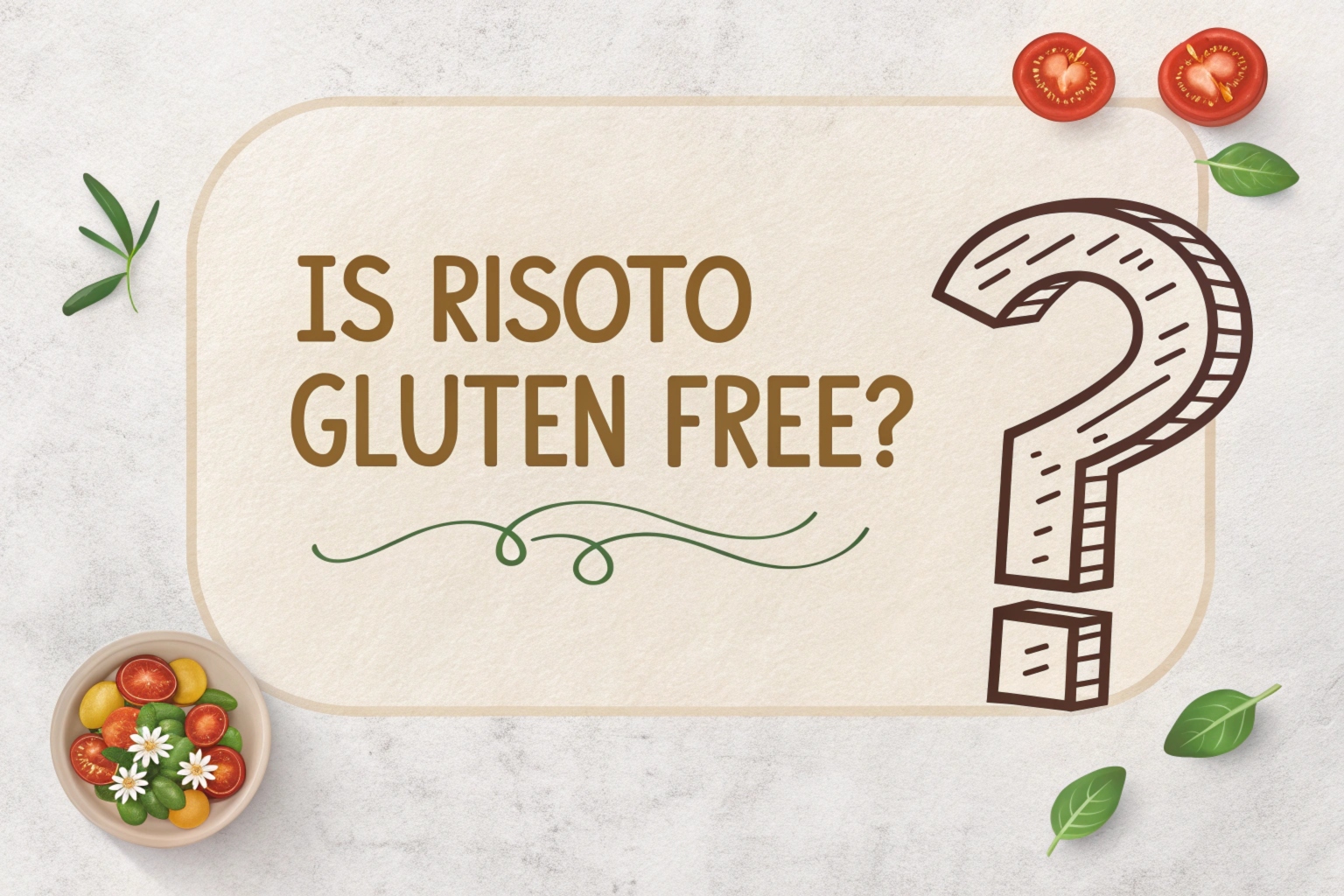Risotto is one of the most iconic dishes in Italian cuisine, loved worldwide for its creamy texture and comforting flavors. Whether served as a main course or a side dish, risotto’s versatility allows it to shine in a variety of settings, from casual family dinners to fine dining experiences. However, for individuals with gluten sensitivities or celiac disease, the question often arises: “Is risotto gluten free?” While traditional risotto is made with naturally gluten-free ingredients, the presence of gluten can depend on how it is prepared. In this article, we’ll delve into the details of what makes risotto gluten free, explore potential sources of gluten, and provide tips for making safe and delicious gluten-free risotto at home.
By the end, you’ll have a comprehensive understanding of risotto’s gluten status, how to adapt recipes for specific dietary needs, and how to enjoy this Italian classic without worry.
What is Risotto?
Risotto is a creamy rice dish originating from Northern Italy, often considered the epitome of comfort food. The hallmark of risotto is its rich and velvety texture, achieved through a meticulous cooking process that involves slow cooking short-grain rice in broth while stirring continuously. Unlike simple boiled rice, risotto requires a more hands-on approach, gradually adding liquid to the rice to coax out its starch content. This process creates the characteristic creamy consistency that makes risotto so unique.
The traditional ingredients of risotto are quite simple: Arborio rice, broth, butter, parmesan cheese, and a touch of white wine. However, its versatility allows for endless variations, incorporating everything from mushrooms and seafood to seasonal vegetables and exotic spices. The result is a dish that is both luxurious and deeply satisfying, a true celebration of Italian culinary artistry.

The Gluten Status of Risotto
The gluten-free status of risotto depends largely on the ingredients used and the preparation method. The primary ingredient in risotto, Arborio rice, is naturally gluten free. However, gluten can find its way into the dish through certain additives or cooking practices. For people with gluten sensitivities or celiac disease, understanding these potential pitfalls is essential.
Risotto is often considered a safe choice because it is fundamentally based on rice, a naturally gluten-free grain. However, it’s important to remember that some pre-packaged risotto mixes, broths, or seasoning packets may include gluten-containing ingredients such as wheat-based thickeners or flavorings. Additionally, cross-contamination in the kitchen can introduce gluten, especially in restaurant settings or shared cooking spaces.
By carefully selecting certified gluten-free ingredients and adopting proper cooking practices, risotto can be made entirely gluten free, ensuring it is safe and enjoyable for everyone.
Primary Ingredient: Arborio Rice
The foundation of any good risotto is Arborio rice, a short-grain variety prized for its ability to absorb liquid while maintaining a firm texture. Arborio rice is naturally gluten free, making it a safe option for those with gluten sensitivities. Its high starch content is what gives risotto its signature creamy texture, a quality that sets it apart from other rice dishes.
When purchasing Arborio rice, it is crucial to check the packaging for any potential cross-contamination warnings. Some brands may process their rice in facilities that handle gluten-containing grains, which can lead to trace amounts of gluten in the final product. To ensure safety, opt for brands that are labeled “certified gluten free.” This certification guarantees that the product has been tested and meets strict gluten-free standards.
For those looking to experiment, other short-grain rice varieties such as Carnaroli or Vialone Nano can also be used to make risotto. These alternatives share similar qualities with Arborio rice and are equally capable of producing a creamy, satisfying dish.
Common Sources of Gluten in Risotto Recipes
While Arborio rice is inherently gluten free, other ingredients commonly used in risotto recipes may introduce gluten. Being aware of these potential sources is critical for ensuring your risotto remains safe to eat.
- Broth or Stock: Store-bought broths and stocks are one of the most common sources of hidden gluten. Many brands use wheat-based thickeners, flavorings, or soy sauce, all of which can contain gluten. To avoid this, always read labels carefully and choose broths labeled “gluten free” or prepare your own at home using simple ingredients.
- White Wine: While most white wines are gluten free, some may use gluten-containing agents during the clarification process. Check with the manufacturer or opt for a wine that is certified gluten free to be certain.
- Seasoning Blends and Pre-Made Sauces: Pre-packaged risotto mixes, spice blends, or sauces may include gluten-containing additives or preservatives. It’s best to stick to whole, natural ingredients and season your risotto yourself.
- Cross-Contamination: Gluten can inadvertently be introduced into your risotto if it is prepared in a shared kitchen or with utensils that have been in contact with gluten. To minimize this risk, use dedicated cookware and utensils for gluten-free cooking.
By staying vigilant and choosing gluten-free certified products, you can eliminate these potential sources of gluten and ensure your risotto remains safe to enjoy.
Making Gluten-Free Risotto at Home
One of the best ways to enjoy gluten-free risotto is by making it yourself. Cooking at home allows you to have complete control over the ingredients and preparation methods, ensuring that your dish is both delicious and safe.
Ingredients to Use
To make gluten-free risotto, you will need the following:
- Arborio rice: Look for certified gluten-free varieties to avoid cross-contamination.
- Gluten-free broth: Choose a high-quality broth labeled gluten free or make your own by simmering vegetables, herbs, and spices.
- White wine: Ensure it is gluten free or substitute with a splash of white wine vinegar for a similar tangy flavor.
- Olive oil or butter: These add richness and depth to the dish.
- Fresh vegetables or proteins: Ingredients like butternut squash, mushrooms, asparagus, shrimp, or chicken can enhance the flavor and nutritional value of your risotto.
- Cheese: Parmesan cheese or vegan alternatives can provide the final touch of creaminess.
Substitutions for Common Additives
If you need to replace gluten-containing ingredients, here are some easy swaps:
- Use cornstarch or arrowroot powder instead of wheat-based thickeners.
- Replace breadcrumbs with gluten-free alternatives if a crispy topping is desired.
- Substitute nutritional yeast for parmesan cheese to create a vegan and gluten-free risotto.
Cooking Tips for Gluten-Free Risotto
- Use the right pot: A heavy-bottomed pot or Dutch oven ensures even heat distribution and prevents sticking.
- Stir constantly: This helps release the starch from the rice, creating a creamy texture.
- Add broth gradually: Let the rice absorb each ladle of broth before adding more to control the consistency.
- Season thoughtfully: Balance flavors with salt, black pepper, and fresh herbs like chives or parsley.
Serving Suggestions for Gluten-Free Risotto
Gluten-free risotto is incredibly versatile and pairs well with a variety of dishes. For a complete meal, consider serving it with grilled meats, roasted vegetables, or seafood. For a vegetarian option, pair risotto with a fresh green salad and a light vinaigrette. Garnishing with grated parmesan cheese, a drizzle of high-quality olive oil, or fresh herbs adds a final layer of flavor and sophistication.
Gluten-Free Variations of Risotto
Risotto’s adaptability allows you to explore endless variations that cater to different tastes and dietary needs. Here are some popular gluten-free options:
Cheese Risotto
A simple yet indulgent option, cheese risotto combines Arborio rice with parmesan cheese for a dish that is creamy, rich, and utterly satisfying. For a dairy-free twist, use vegan cheese or nutritional yeast to achieve a similar texture and flavor.
Crab Risotto
Perfect for seafood lovers, crab risotto combines the sweetness of fresh crab meat with the creamy base of traditional risotto. Enhance the flavor with a splash of white wine and a touch of lemon zest.
Vegetable Risotto
Loaded with seasonal vegetables, this variation is both healthy and vibrant. Ingredients like butternut squash, asparagus, or peas not only add flavor but also create a visually stunning dish.
Frequently Asked Questions
Gluten in Restaurant Risotto Dishes
Risotto served in restaurants may not always be gluten free due to potential cross-contamination or the use of gluten-containing broths and additives. To ensure safety, communicate your dietary needs clearly with the staff and inquire about the ingredients used.
Potential for Dairy-Free Options
Many risotto recipes can be adapted to be dairy free by replacing butter with olive oil and cheese with vegan alternatives like nutritional yeast. These substitutions maintain the dish’s creamy texture while accommodating dietary restrictions.
Health Benefits of Risotto
Risotto is more than just comfort food; it can also be a nutritious meal. Arborio rice is a good source of carbohydrates, providing sustained energy. Incorporating vegetables and lean proteins into your risotto adds vitamins, minerals, and essential nutrients, making it a well-rounded dish.
Conclusion: Enjoying Risotto Without Gluten
Risotto is a comforting and versatile Italian dish that can be easily adapted to fit a gluten-free lifestyle. By selecting the right ingredients and taking care to avoid cross-contamination, you can create a safe and delicious risotto that rivals any restaurant-quality meal. Whether you’re crafting a classic cheese risotto, experimenting with seafood, or showcasing seasonal vegetables, there are endless ways to enjoy this Italian classic without gluten. So grab your favorite ingredients, fire up the stove, and savor a bowl of risotto that’s as satisfying as it is safe.
To enrich your understanding of risotto and related gluten-free recipes, consider these resources from Recipes Focus:
- Short-Grain Rice – Learn about the varieties of short-grain rice suitable for risotto.
- High Protein Soup – Explore gluten-free soup recipes that complement risotto.
- How to Thicken Alfredo Sauce – Tips for thickening sauces, applicable to risotto preparations.

